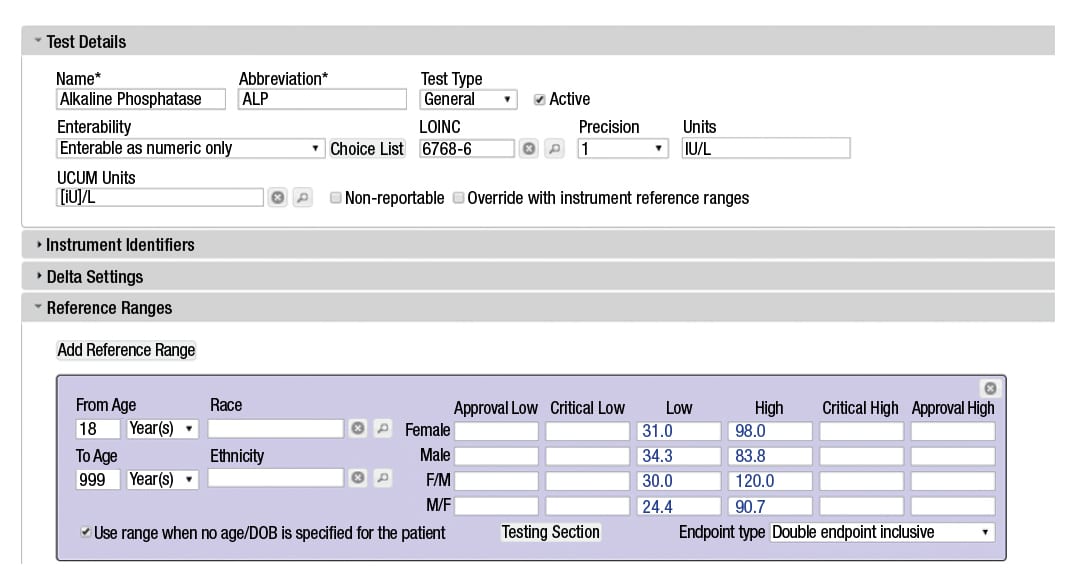How Orchard Software is helping labs address transgender care
June 2019—Establishing useful reference ranges for cisgender patients can be difficult, and for transgender patients it can be even more challenging. Add to this the desire to show the reference ranges for transgender patients as separate categories, distinct from the values for male and female patients, and the challenges mount for some medical centers.
Recognizing the health care-related ramifications of societal changes in gender identity, Orchard Software has, for the past decade, been focusing on how to address transgender issues in the pathology lab. To this end, the company plans to include functionality in the third quarter release of its Sequoia enterprise lab information system and Trellis point-of-care software that allows laboratories to configure the products to show four categories for reference ranges: male, female, male-to-female, and female-to-male.
“It’s up to the laboratory performing the testing to establish reference ranges based on standard practice,” says Nancy Stoker, Orchard’s vice president of product management. “What we’ve done is respond to providers who say, ‘I have the transgender community in our patient population mix, so I want to start establishing reference ranges.’ And once they do that, our software will allow them to put in those reference ranges.”
The new functionality can be added to existing Sequoia and Trellis installations when users download a general upgrade, beginning with the third quarter release, says product manager Greg Lyons. “We have roughly two major releases a year that we consider upgrades to Trellis and Sequoia,” he explains. “After this next release, users will have the ability to check a box indicating they want to include reference ranges for transgender categories in the test results. Once they check that box, the [transgender] fields will be available for all tests.” Values for transgender reference ranges can be entered during test setup, Lyons adds. If no reference range for transgender patients exists for a test, the boxes in the transgender categories will be blank and the report will default to the values for cis males, which is the same default that occurs when the gender of the patient is not known.
The upgrades, including the new transgender functionality, are included in the client’s service contract for no additional cost, Lyons says. The new features do not require additional training, “other than letting clients know where they can turn it on and where it’s going to show up. There’s usually a follow-up call after an upgrade to explain the changes, and we require clients to upgrade their test system before they upgrade their production system so they have a chance to validate the configuration.”
Orchard added transgender reference range functionality to Harvest, its 25-year-old LIS, in a December 2018 release. However, the LIS uses result evaluation rules to show transgender reference ranges as a comment within the results, Lyons explains. “It’s generally a block of text that tells the physician, ‘This patient is transgender and the appropriate reference range is . . . ,’ and then the comment displays the range established by the laboratory for that test/gender pair. Or it may say, ‘This patient is transgender; this laboratory has not established reference ranges for this population. Please correlate results with the complete clinical picture.’” Users can configure the reference range comment functionality by creating rules that dictate which tests and which conditions will trigger a reference range within a comment. The functionality was also incorporated into Trellis and Sequoia within the past year.
Orchard was already aware that reference ranges were an issue in transgender care, Stoker says, when she received a phone call from Andrew M. Quinn, MD. Dr. Quinn, codirector of pathology informatics at the University of Texas Southwestern Medical Center, was doing research for his 2018 American Association of Clinical Chemistry annual scientific meeting presentation, “Clinical Laboratory’s Role in the Care of Transgender Patients: Informatics Considerations.” Stoker explains: “Dr. Quinn asked if we could configure reference ranges for transgender patients. His request coincided with queries from our client base, so we made the decision to go ahead and do it.”

A partial screenshot showing the transgender reference range functionality (bottom right) incorporated into Orchard Software’s Sequoia enterprise laboratory information system and Trellis point-of-care software.
Orchard’s commitment to supporting the transgender community goes back at least 10 years, when the company added functionality to Harvest to allow users to configure male-to-female or female-to-male as the designated sex of the patient. All Orchard products have had that configuration for “quite some time,” Stoker notes. While the company is not working on additional gender-related functionality at this time, Stoker says Orchard is “always listening to what we’re being asked. We do a lot of industry research, and we want to keep our finger on the pulse of what our clients need.”—Jan Bowers
Proscia adds functionality to digital pathology platform
Proscia has announced the spring 2019 release of its Concentriq digital pathology solution, which includes a performance analytics metrics dashboard, automation-enabled worklists, and an enhanced quick-action case viewer.
 CAP TODAY Pathology/Laboratory Medicine/Laboratory Management
CAP TODAY Pathology/Laboratory Medicine/Laboratory Management
